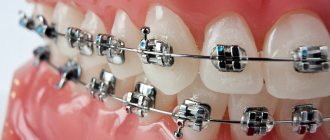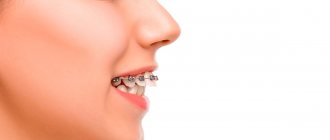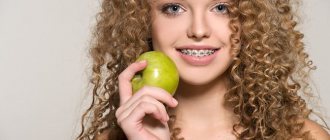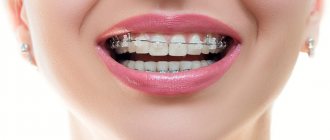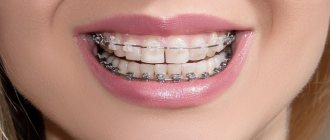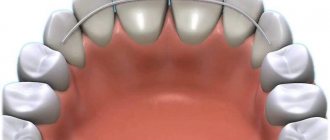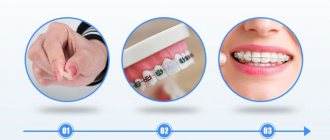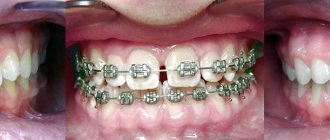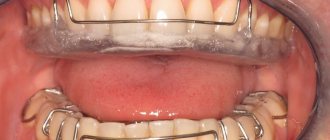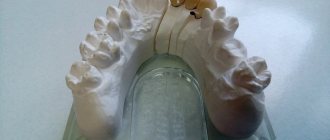Immediately after installation, braces can rub the oral mucosa and cause irritation. In most cases this is normal, you just need to be patient. If the discomfort does not go away and the symptoms intensify, you should see a doctor. In this article we will tell you what to do if your braces rub your cheeks, lips or tongue.
In this article
- When rubbing the mucous membrane with braces is the norm
- Braces rub cheeks: reasons
- What to do if braces rub your cheeks
- Wax for braces to prevent chafing
- Hygiene after installing braces
Braces are complex orthodontic structures consisting of many small parts. They are made from different materials - ceramics, plastic, sapphire or metal. Regardless of the type of system, the arc in it is always metal. It has memory and after installing braces it begins to return to the shape that was given to it during system modeling. She puts pressure on the teeth, gradually moving them in the desired direction. Due to this, the bite is slowly corrected and irregularities in the dentition are eliminated.
Braces place quite a lot of stress on the jaws. Immediately after their installation, a person feels discomfort in the oral cavity and even pain. Usually, unpleasant symptoms disappear within a few days or weeks.
People often complain that braces rub or scratch their lips and cheeks, causing small sores that bleed and hurt, especially when eating. In some cases, irritation of the tongue mucosa is observed, which can occur after the installation of lingual braces fixed on the inside of the dentition. Let's find out when such symptoms are normal and when they are not.
When rubbing the mucous membrane with braces is the norm
The oral mucosa is covered with a thin epithelial layer, penetrated by many blood vessels. Minor injuries, some products and orthodontic structures can disrupt its integrity and cause irritation. Braces are a foreign object for the body, which, when in contact with the mucous membrane, can cause a certain reaction. This happens especially often when teeth protrude strongly towards the cheeks or lips. In addition, the design itself is quite voluminous, so in some sense it increases the size of the jaw. Because of this, the contact of braces with the tissues of the oral cavity becomes more dense.
The mucous membrane recovers very quickly, without any treatment. Within a few days after installing the braces, a person ceases to feel any discomfort. If the problem does not go away, and the symptoms of damage to the mucous membrane intensify, you need to consult a doctor.
The following signs may be a reason for a visit:
- bleeding of the mucous membrane;
- pain while eating;
- the formation of ulcers and wounds covered with a white film.
If an infection gets into the wound, an inflammatory process will begin. Therefore, if you are concerned about several of the listed signs, do not try to eliminate them yourself. Most likely, the cause of these symptoms is not related to adaptation.
Gum inflammation
During and after orthodontic treatment, the patient begins to notice that while wearing braces, his gums have receded. Inflammation of soft tissues occurs due to poor dental care, lack of vitamins or incorrectly installed orthodontic system.
In rare cases, a complication of wearing braces is gum recession and exposure of tooth roots.
In most cases, the inflammatory process in the gums while wearing braces begins due to poor hygiene. Braces make the cleaning process more difficult, which often leads to plaque deposits and tartar formation. As a result, problems begin, the gums bleed and hurt. The same symptoms can be observed after braces are removed.
A more rare reason is incorrect installation of the orthodontic system or its manufacturing errors. In these cases, braces can injure the gums, after which inflammation begins. If, some time after installing an orthodontic system, you notice that your gums are swollen, pain, and bleeding appear, then it is better to visit an orthodontist. This is necessary to eliminate the possibility of incorrect position of the braces.
A similar situation can be observed after braces are removed for the same reason - weakening of the gums occurs as a result of the accumulation of plaque, which is a breeding ground for various bacteria and pathogenic microorganisms.
It is important to recognize inflammation in the early stages and go to the orthodontist so that the doctor can prescribe treatment. When wearing braces, it is important to regularly brush your teeth twice a day and after every meal, and the use of an irrigator is recommended.
Braces rub cheeks: reasons
There are four possible reasons why braces chafe your cheeks, lips, and tongue. Among them:
- Error when installing the arch of the orthodontic structure. The orthodontist may incorrectly trim or bend the archwire, making it too long. As a result, it begins to scratch the tissues of the oral cavity. The problem is eliminated by partially dismantling the system and reinstalling the arc.
- The lock has come unglued from the enamel. One of the main parts of the structure is the locks, which are fixed to the tooth surface using dental cement. If one of the locks has lost contact with the enamel and become detached, it will most likely rub against your cheek or lip. This rarely happens, since the fixation of the braces should be as tight as possible so that they do not move even as a result of pressure. This may lead to incorrect correction. However, the likelihood of such a complication still exists, albeit low.
- The arch of the braces jumped out of the slots of the locks. This problem also occurs rarely. The reason for its appearance is an error when installing braces or non-compliance with the rules for wearing them. Thus, a person may press too hard on the system with a toothbrush or damage it when consuming hard foods, such as carrots. If the arch from the braces jumps out of the grooves, it begins to come into contact with the mucous membrane and rub it.
- Allergy to construction material. Sores, wounds, bleeding and other symptoms may be the result of an allergic reaction. Often it occurs on some metal. In this case, it is necessary to reinstall the system, and you will have to replace it with plastic, sapphire or ceramic. You may need to give up braces in favor of aligners.
In some cases, the adaptation period is delayed, which is associated with the individual characteristics of the body, for example, increased sensitivity of the mucous membrane. To reduce the risk of developing inflammatory diseases, it is recommended to carefully observe the rules of hygiene and eat right.
Periodontal disease
The most difficult option that can be encountered during orthodontic treatment is periodontal disease. This disease affects both gums and dental tissue.
Only a dentist should treat periodontal disease. The doctor removes tartar, performs professional teeth cleaning and puts special compounds into the periodontal pockets. In many cases, to eliminate periodontal disease, surgical intervention is prescribed to free the pockets from the remains of affected tissue and accumulated food particles, as well as splinting the teeth (fixing them to neighboring ones).
What to do if braces rub your cheeks
If discomfort in the oral cavity does not go away after installing orthodontic braces, you will need the help of a specialist. Depending on the cause of the problem, he will select a method to eliminate it:
- glue the detached lock to the tooth surface, having previously removed the old glue with a solvent;
- will cut off both edges, bend and reinstall an arch that is too long;
- will put the arch in place if it has jumped out of the grooves due to the patient violating the rules of wearing braces;
- will replace the arc with a product made of a different material if the discomfort is caused by an allergy.
It is also necessary to help the patient quickly adapt to the design. To do this, he is prescribed special gels and ointments that can be used at home. If ulcers form, the doctor will select a healing or anti-inflammatory ointment to prevent the spread of infection.
Gingivitis
The most common inflammation of the gums, the cause of which is insufficient oral hygiene when wearing braces. The patient feels pain, notices bleeding while brushing his teeth, and redness of the tissue becomes noticeable.
In the early stages, gingivitis does not require drug treatment. In the initial stages of inflammation, dentists recommend using dental floss, an oral irrigator, and including more solid foods in your diet to train your gums. An excellent massage will be provided by fresh fruits and vegetables, cheese, and nuts.
A course of vitamin therapy will also help strengthen your gums. Any drug with a balanced composition will keep the body in balance. If the inflammation, despite careful hygiene, does not calm down, you can try home rinses.
An important stage in the treatment of gingivitis is the use of local agents to normalize the condition of the mucosa. For these purposes, decoctions of chamomile and calendula are used, as well as various rinses, sprays, gels, and lozenges.
ASEPTA ACTIVE mouth rinse will help reduce bleeding gums and reduce tissue inflammation. This unique remedy with benzydamine, chlorhexidine, mint and menthol has a combined antimicrobial, anti-inflammatory and analgesic effect. The product provides an instant anesthetic effect and quickly reduces pain.
Wax for braces to prevent chafing
If braces rub the cheek, the dentist may prescribe orthodontic wax - a special composition that is applied to the structure to protect the mucous membrane from rubbing. The composition of such products is hypoallergenic, so they are suitable for all patients. Wax is recommended to be used not only during the adaptation period, but also after tightening the braces. It should be used according to the instructions:
- Dry the part of the structure that will be waxed using cotton swabs.
- Tear off a small piece of the mixture, warm it with your fingers and roll it into a small ball.
- Attach it to the protruding part of the staples using light pressure (the wax should not be under the metal elements of the structure).
Before eating, you need to remove the wax from the braces with a brush, cotton swab or brush. But nothing bad will happen even if you swallow a little of this product. It is absolutely safe for health, including for children.
If your braces continue to scratch your cheek or lips even with wax, the system may need to be removed. The need for this will be determined by an examination.
Modern drugs
An anesthetic may be used to reduce discomfort when braces rub. It can be purchased at the pharmacy in the form of a gel or rinse. This remedy will relieve pain for several hours.
It is also convenient that you can buy anesthetics in almost any pharmacy, without a doctor’s prescription.
The most common products are Colgate Orabase and Orajel.
How to use these tools is described in detail in the attached instructions. Before use, be sure to study the composition and contraindications.
Hygiene after installing braces
After installing braces, the requirements for oral hygiene increase, especially during the period of adaptation to the system. If you don't brush your teeth or do it poorly, germs can get into the wounds caused by rubbing. Due to the infection, treatment will be delayed. It is possible that you will have to remove the staples, treat the pathology and put them back on.
To prevent this, use special hygiene products to care for braces: brushes, dental floss, mouthwash with antibacterial properties and a special brush with V-shaped bristles.
Orthodontists also recommend cleaning your mouth 2-3 times a week with an irrigator. It is necessary to select devices with attachments designed for the care of orthodontic systems, for example, Little Doctor International Ltd Aquajet LD-A7 and Donfeel Donfeel OR-820D Compact. Before purchasing brushes and other hygiene products, consult your doctor.
How to avoid unpleasant consequences?
Preventing the consequences of wearing braces includes actions such as:
- Careful daily oral hygiene.
During daily procedures, it is important to use not only a brush and toothpaste, but also dental floss, an irrigator, and orthodontic brushes. When brushing your teeth, do not put excessive pressure on the enamel and gums. - Elimination of self-removal of the structure.
Only a dentist should remove the braces system; under no circumstances should you try to dismantle it yourself, even if there is a good reason for doing so. - Timely contact with the orthodontist.
If the structure becomes loose or broken, it is important to contact a specialist as soon as possible. The orthodontist will examine your mouth and, if necessary, your braces.
We hope your orthodontic treatment will be successful, and after the braces are removed, you will be the happy owner of a beautiful smile. Take care of your teeth and remember, ASEPTA products will always help you cope with any dental problem.
Sources:
- The effectiveness of the use of Asept “adhesive balm” and Asept “gel with propolis” in the treatment of chronic generalized periodontitis and gingivitis in the acute stage (Municipal Dental Clinic No. 4, Bryansk, Kaminskaya T. M. Head of the therapeutic department Kaminskaya Tatyana Mikhailovna MUZ City Dental Clinic No. 4, Bryansk
- Report on clinical trials to determine/confirm the preventive properties of commercially produced personal oral hygiene products: mouth rinse "ASEPTA PARODONTAL" - Solution for irrigator." Doctor of Medical Sciences Professor, Honored Doctor of the Russian Federation, Head. Department of Preventive Dentistry S.B. Ulitovsky, doctor-researcher A.A. Leontiev First St. Petersburg State Medical University named after academician I.P. Pavlova, Department of Preventive Dentistry.
- Clinical studies of antisensitive toothpaste “Asepta Sensitive” (A.A. Leontyev, O.V. Kalinina, S.B. Ulitovsky) A.A. LEONTIEV, dentist O.V. KALININA, dentist S.B. ULITOVSKY, Doctor of Medical Sciences, Prof. Department of Therapeutic Dentistry, St. Petersburg State Medical University named after. acad. I.P. Pavlova
- Report on the determination/confirmation of the preventive properties of personal oral hygiene products “ASEPTA PLUS” Remineralization doctor-researcher A.A. Leontyev, head Department of Preventive Dentistry, Doctor of Medical Sciences, Professor S.B. Ulitovsky First St. Petersburg State Medical University named after. acad. I.P. Pavlova, Department of Preventive Dentistry
